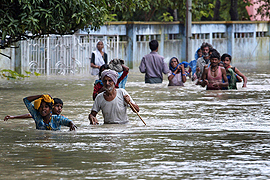India struggles with flood rescue
Twenty people reported dead after boat carrying survivors capsizes in Bihar state.

The death toll from this year’s monsoon season across India has climbed past 800, mostly from northern Uttar Pradesh state, and around 85 from Bihar.
The river Kosi burst its banks and changed course earlier in the month, swamping hundreds of Bihar’s villages, submerging all roads leading to the region and trapping about 1.2 million people.
National calamity
India’s prime minister declared the flooding a “national calamity”, pledging $200m in relief aid and 125,000 tonnes of grain for those affected.
At least 300,000 people have so far escaped their homes and are living in government relief shelters, temples and high-rise government buildings, due to the flooding.
But soldiers were reportedly facing problems getting to the survivors because of strong currents.
Prataya Amrit, secretary of the state’s disaster management department, said: “Large-scale evacuation will continue until all the marooned people are rescued in the next three to four days.”
“We can’t assess the extent of the damage – it is colossal. But we will only be able to tell the extent after the water recedes.”
Long-term reconstruction
The government says the situation is unlikely to return to normal for months and has set up more than 100 shelters.
Nitish Mishra, the state’s disasater minister, said: “We will have to provide food and shelter to the survivors until October, as they will not be able to return home.”
Al Jazeera’s Matt McClure, reporting from the Saharsa district of Bihar, said some survivors at relief camps were not getting supplies.
“From what we’ve seen on the ground, certainly there are supplies arriving at the district co-ordination centre[s],” he said.
 |
| Hundreds of thousands of villagers have been forced to abandon their homes [AFP] |
“But there’s difficulty with both distributing that food relief because of roads and flooding, and also a lack of co-ordination, I would suggest.
“We talked to people who were in relief camps who were complaining. They trekked for kilometres to arrive there and there was nothing there for them. They had been promised food and they weren’t getting it.”
Tens of thousands of people have been displaced in neighbouring Nepal as well, where thousands of Indians seeking shelter from floods in Bihar have migrated.
Amrit said the situation was getting worse because of heavy rains in the region and the breach in the embankment in the Kosi river that is swelling on the Nepalese side.
Officials warn that the worst danger could still lie ahead, as the river traditionally swells to a flood peak in October.
In 2007, monsoon floods killed more than 2,200 people across South Asia and left 31 million others homeless, short of food or with other problems. The United Nations called last year’s floods the worst in living memory.